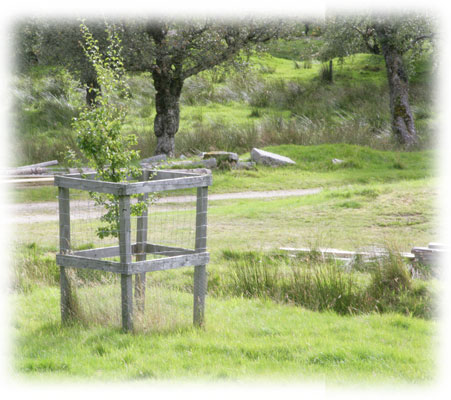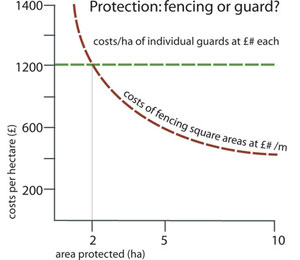Aim

To aid the establishment of trees in the presence of deer, the choice of the species of tree planted and the method used to protect them will be key factors. The aim of this guide is to provide advice and information on appropriate methods for protecting trees from browsing or fraying by deer.
Choice of tree species
When choosing the species of tree to plant consider the following:
- The land use objective.
- Match the choice of tree with the site in relation to soil type, altitude and topography.
- Take into account the relative vulnerability of different species to deer impacts (see table below and right).
The following tables show the relative vulnerability of some common trees and shrubs to deer impacts. The table assumes that all plants are being established on appropriate soils and sites. The tables highlight which species may not require individual protection whilst others planted in the area may; e.g. pioneer species such as alder, birch and hawthorn may not require protection, whereas slower growing climax species in the same mix such as ash, oaks etc may do so. Vulnerability can also be affected by positioning and palatability of species.
| relative vulnerability | ||
| High | Med | Low |
| Ash | Beech | Alder |
| Aspen | Blackthorn | Birches |
| Firs | Cedar | Hawthorn |
| Hazel | Cherries | Sitka spruce |
| Holly | Corsican pine | Sycamore |
| Norway spruce | Crab apple | |
| Oaks | Elm | |
| Rowan | Larch | |
| Scots pine | Lodgepole pine | |
| Willows & sallow | ||
Types of Protection

There are a number of methods of protection that can be used which are described below.
Culling –maintaining low deer densities to prevent over-browsing and fraying of tree species. Culling may still be required where individual protection is in use to control populations.
Fencing*– excluding deer from areas using fences. Includes permanent, temporary and electric types. For a description of fencing types see BPG Fencing.
Tree shelters – plastic. Provide protection from browsing and barkstripping or fraying damage while the sapling remains within the tube. Height of tree shelter or guard used will depend on species of deer present – 1.2m for Roe, 1.8m for Fallow, Sika and Red deer.
Tree guards – wire or plastic mesh. Provide protection from bark-stripping or antler damage and protect the terminal bud from browsing (lateral shoots can grow through the mesh). Suitable for both broadleaves and conifers.
Plastic net guards provide suitable protection from roe deer and thicker plastic mesh guards, if well supported, also provide reasonable protection from larger species. Welded wire mesh guards give the most effective protection. In parks and amenity areas, individually made ‘basket’ guards of vertical metal palings may be constructed to provide long-term protection of specimen trees even into maturity.
Chemical repellent – chemicals applied to provide a deterrent to browsing deer. Also used to discourage deer from areas. Chemicals must be approved for use by the pesticides registration scheme.
Diversionary feeding** – crops or habitat can be protected by providing alternative feeding for wild deer. There are two potential approaches: use of artificial food stuffs and habitat management.
Method to use
To determine the most appropriate method of tree protection of the planting area, a number of factors should be taken into account. These should include:
- The value and vulnerability of the crop;
- The area of crop requiring protection and planting density;
The cost of the method; - Labour input, aftercare and maintenance required e.g. trees grown fast and thin in guards may need staking once guards are removed;
- The time period that the crop may be vulnerable to deer damage;
- Deer species present (i.e. height deer can browse);
- Potential impacts on landscape quality and access enjoyment;
- Multi use of the area i.e. stock grazing between trees.
Based on the criteria above, the following table provides guidance on the relative comparison of different methods.1
| High | Pros | Cons | Most suitable for |
| Culling | Positive herbivore impacts may be maintained. May provide a recreational resource and a source of income.*** | May be labour intensive to plan and carry out. May require collaboration with neighbours. Opportunities may be limited in areas of regular or high public usage. | All sizes of areas of valuable/ vulnerable species/crops. |
| Fencing* | May be cost effective for large areas and densities of trees. May have less visual impact than tree guards or shelters. Offers additional protection for regeneration of other habitat species. | Less cost effective for small areas. May reduce public access opportunities. Requires regular on-going maintenance. May prevent positive herbivore impacts. May require compensatory cull to be carried out. **** |
Medium to large areas of valuable/ vulnerable species/crops. |
| Tree shelters | Shelter may provide a microclimate which itself acts to promote growth of the tree. | Less suitable for conifers, and some species of broadleaves do not favour the microclimate within the shelter. May lead to saplings that lack rigidity. Less suitable for where lateral as well as vertical growth is required e.g. for establishment of hedging or shelter-belts. May be unsightly. | Medium to large areas of less valuable but vulnerable species/crops with landscape value. |
| Tree guards | Cost effective for small areas. May be appropriate within sensitive landscapes as mesh tree guards tend to have less landscape and visual impact than plastic tubes. No barrier to public access. May allow multi use of area. Surrounding ground vegetation may benefit from positive herbivore impacts. Tend to be relatively durable, lasting up to 20 years. |
Less cost effective for large areas. Require to be inspected and maintained on regular basis. May require to be removed and generally not reusable. Do not protect other elements of woodland habitat. |
Small areas of valuable/ vulnerable species/crops. |
| Chemical repellants | May be a useful emergency option for small areas where immediate and over-winter protection is required. | Limited duration of protection requiring regular renewal. Unsuitable for large-scale use. Less cost effective for large areas. | Small areas of valuable/ vulnerable species/crops. |
| Diversionary feeding** | Additional benefits associated with feeding of mineral or urea blocks may increase digestibility of natural forage available overwinter. | Method may be expensive and labour intensive. Animals may develop a reliance on feed. Concentrations of animals at feed sites may increase local environmental damage and increase disease and parasite transmission. | Small areas of valuable/ vulnerable species/crops. |
